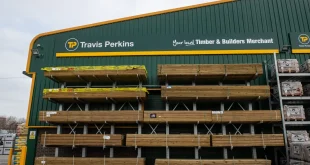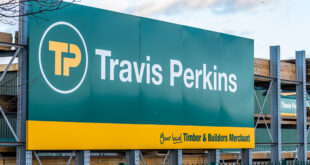Travis Perkins’ Head of Sustainability, Megan Adlen, on how our handling of the Covid situation will make business stronger in the long term.
If this year has taught us anything, it’s that we can adapt when we need to, and that the evolution of our mindsets is something we should hold onto. From carbon emissions to waste, from wellbeing to diversity; the construction industry has a huge impact on the environment and society – and we can make it a positive impact by working together.
I recently spoke with the Builders Merchant Federation members at their Annual Conference on ‘Building a Sustainable Britain’ in order to share ideas and encourage continued collaboration and adaptability in our approach.
Sustainability is about managing economic, social and environmental risks and opportunities. Our industry, like many others, must play its part in dealing with the impact of climate change – buildings represent over a third of UK emissions. However, the Sustainability agenda is about so much more than this: the war on waste, a lack of diversity in the construction industry workforce, mental health challenges and modern slavery risks must also be on our roadmap. We must adapt early, adopt new methods of construction, be proactive in our recruitment and promotion strategies and actively manage our global supply chains to ensure that standards are kept. There are many upsides to the successful management of sustainability and we must start now.
COVID-19 would have been an outlying risk at best on many corporate risk registers, yet it has materialised. This has focused attention within businesses and also from investors on ESG (Environmental, Social, Governance) performance as they seek to prevent significant impacts from known and high-impact ESG risks, not least climate change. COVID-19 has been a huge test of resilience and has underlined the importance of our industry – providing essential services to keep people warm, dry and safe whilst supporting the building of important projects in response to the pandemic. COVID-19 has impacted the use of buildings for many of us, with more now working from home, the need to redesign COVID-safe workplaces or offices standing vacant. As such, questions start to arise – How can we make our homes more efficient, lower-cost, comfortable and fit for our new lifestyles? How can we repurpose office blocks so there is better utilisation of space? How can we build better to reduce emissions and waste, improve wellbeing, strengthen communities and prevent future risks from materialising?
As we mobilise to drive the recovery, we need to keep these questions front of mind. COVID-19 has shown us that we are capable of evolving, and that is something we will need to do. To prevent the worst of climate change we need to reduce global carbon by the same amount as was seen in lockdown every year for the next ten years and we can’t do that by doing what we’ve always done.
So, we must pose the question: what can we do? Firstly, we need to hold on to the positive changes from what has been a hugely difficult few months. By supporting workers, where possible, to work from home and by increasing our digital connectivity, we are able to reduce carbon emissions (and costs!) from daily commutes and business meetings. Digitalisation goes hand in hand with decarbonisation; whether moving age-old paper-based operations onto digital and reducing deforestation, or building digital efficiency to our operations and construction processes to reduce waste and improve resource use, digitalisation is key to future sustainability. We need to keep our focus on the whole value chain – the sustainability of our supply chain partners will in many ways determine our own.
We’ve always been an industry founded on relationships and that collaborative mindset has helped us to navigate these last few months together. If we all retain the ‘must change, will change’ attitude, as witnessed over these last few months, we can move forward – not just growing, but growing sustainably.
Secondly, as we build back the economy we must build back better. The Government is ring fencing funds and launching initiatives such as the new £2 billion Green Homes Grant scheme which will fund up to two-thirds of the cost of energy saving improvements for eligible homeowners in England. The current window of opportunity for this scheme only extends to March – risking a ‘boom and bust’ outcome as seen with the Green Deal, although we are of course supporting and promoting the scheme and providing the products and services needed to make it a success. The challenge – and opportunity – is to consider how we can lead on this agenda and create continued demand for home improvements and sustainable homes, supporting Government initiatives of course, but not solely relying upon them to create lasting change.
We have an opportunity to lead by adopting new products and modern methods of construction, and not wait to be led. We can do more and do better together. For example, we hear from customers how they wish certain products were half the size to reduce offcuts and waste. We hear from house building contractors that designers have not thought about the waste impacts of their designs and how small changes could significantly reduce waste. We know that smaller or regional customers do not have large teams with dedicated team members for environment, safety, diversity, modern slavery and other sustainability topics – but they’re keen to learn and to make sustainability work for them.
Whether it’s designing more sustainable products, focusing on the durability and maintenance of products – using predictive maintenance where possible to keep assets in use for longer, sharing more sustainability information and knowledge across our whole value chain, educating home owners and buyers on the building sustainability credentials they could benefit from – there is much that we can do – the important point is that by collaborating we can accelerate the positive impacts for our industry.
At Travis Perkins, we are developing our plans to take a leading role in sustainability. Our future plans will include a commitment to net zero carbon and more focus on the sustainable products and services we can offer to our customers – and definitely more collaboration with our supply chain. We all have a part to play in making our industry and the built environment sustainable and Travis Perkins is committed to being part of the solution.
 Builders Merchants Journal – BMJ Publishing to Builders Merchants and the UK merchanting industry for more than 95 years
Builders Merchants Journal – BMJ Publishing to Builders Merchants and the UK merchanting industry for more than 95 years


